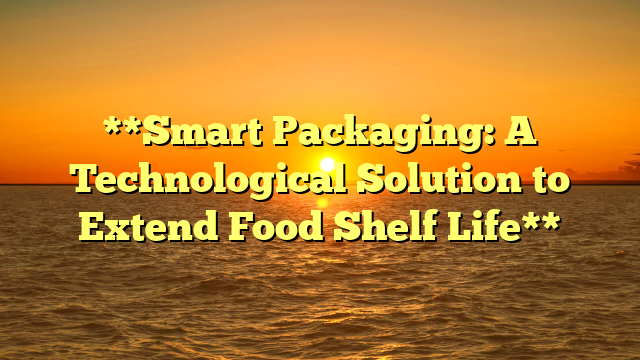
In the global fight against food waste, innovation in packaging is playing a crucial role. Smart packaging, a cutting-edge technological solution, is revolutionizing the way we store and preserve food. By incorporating advanced features such as sensors, indicators, and antimicrobial materials, smart packaging extends the shelf life of food products, reduces waste, and ensures greater safety and quality for consumers. As the world seeks sustainable solutions to food waste, smart packaging is emerging as a game-changer in the food industry.
One of the most significant benefits of smart packaging is its ability to monitor and communicate the condition of food in real time. For example, time-temperature indicators (TTIs) are integrated into packaging to track how long a product has been stored and whether it has been exposed to temperatures that could compromise its quality. This is particularly useful for perishable items like meat, dairy, and seafood, where improper storage can lead to spoilage. By providing consumers and retailers with accurate information about a product’s freshness, smart packaging helps reduce the likelihood of food being discarded prematurely.
Another innovative feature of smart packaging is the use of freshness sensors. These sensors detect gases such as oxygen, carbon dioxide, or ethylene, which are released as food begins to spoil. When the levels of these gases exceed a certain threshold, the packaging changes color or displays a warning, alerting consumers that the product may no longer be safe to eat. This technology not only helps prevent foodborne illnesses but also empowers consumers to make informed decisions about their food, reducing unnecessary waste.
Active packaging is another aspect of smart packaging that enhances food preservation. NS2121 – Situs Judi Online Terbaik of packaging incorporates materials or substances that actively interact with the food to extend its shelf life. For instance, oxygen scavengers can be embedded in packaging to absorb excess oxygen, which slows down the oxidation process that causes food to spoil. Similarly, antimicrobial packaging releases compounds that inhibit the growth of bacteria, mold, and other microorganisms, keeping food fresh for longer periods. These features are especially valuable for products like baked goods, fruits, and vegetables, which are prone to rapid deterioration.
Smart packaging also contributes to sustainability by reducing the need for preservatives and minimizing food waste. By maintaining the quality and safety of food for extended periods, it allows retailers and consumers to store products longer without compromising their integrity. This not only reduces the amount of food that ends up in landfills but also lowers the environmental impact associated with food production, transportation, and disposal. Additionally, some smart packaging solutions are designed to be biodegradable or recyclable, further enhancing their eco-friendly credentials.
The adoption of smart packaging is gaining momentum across the food industry. Major companies and startups alike are investing in research and development to create innovative packaging solutions that meet the demands of modern consumers. For example, **Mimica**, a UK-based company, has developed a temperature-sensitive label that changes texture to indicate when a product is no longer fresh. Similarly, **Apeel Sciences** has created an edible coating made from plant-based materials that extends the shelf life of fruits and vegetables by slowing down water loss and oxidation.
Despite its many advantages, the widespread adoption of smart packaging faces challenges, including higher costs and regulatory hurdles. However, as technology advances and economies of scale are achieved, these barriers are likely to diminish. Governments and industry stakeholders can also play a role by supporting research, providing incentives, and establishing standards for smart packaging.
In conclusion, smart packaging represents a transformative solution to the global problem of food waste. By extending shelf life, enhancing safety, and promoting sustainability, it offers significant benefits for consumers, businesses, and the environment. As the food industry continues to embrace this technology, smart packaging has the potential to revolutionize how we store, preserve, and consume food, paving the way for a more sustainable and waste-free future.







